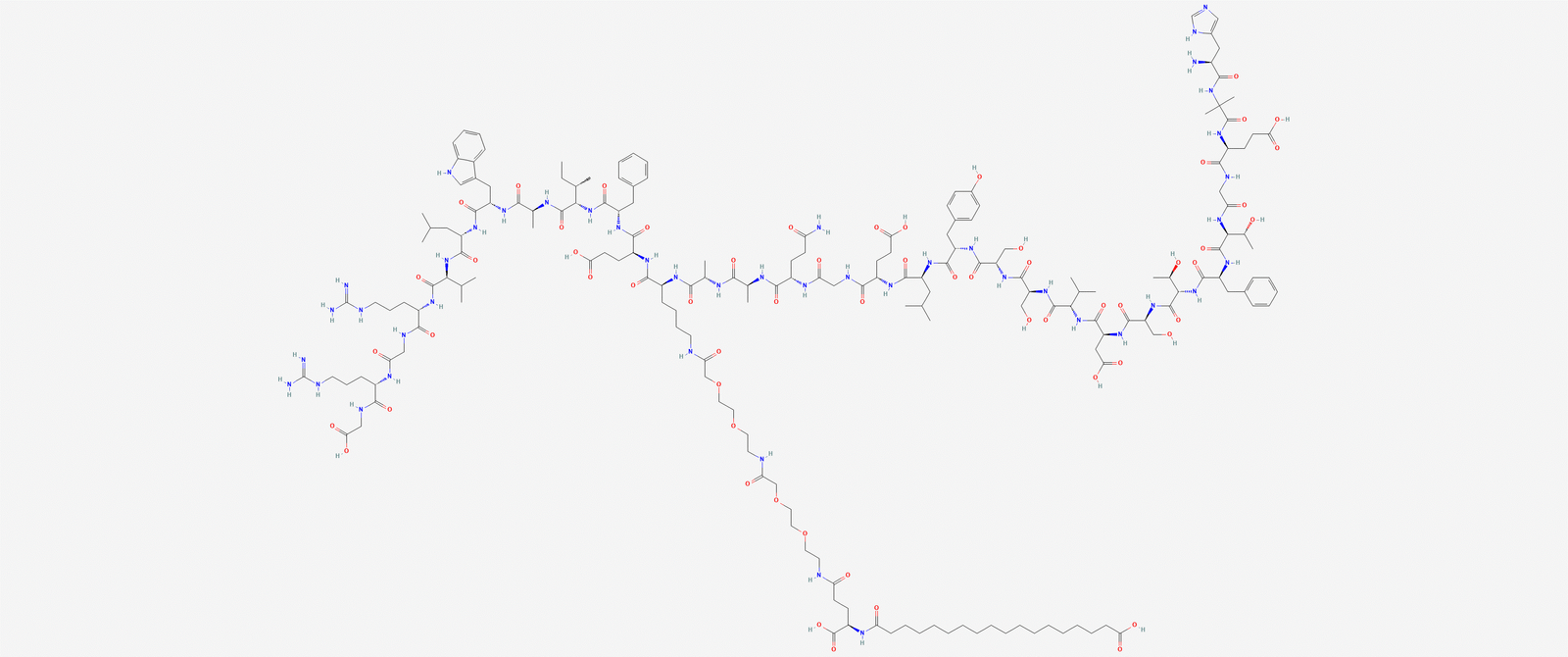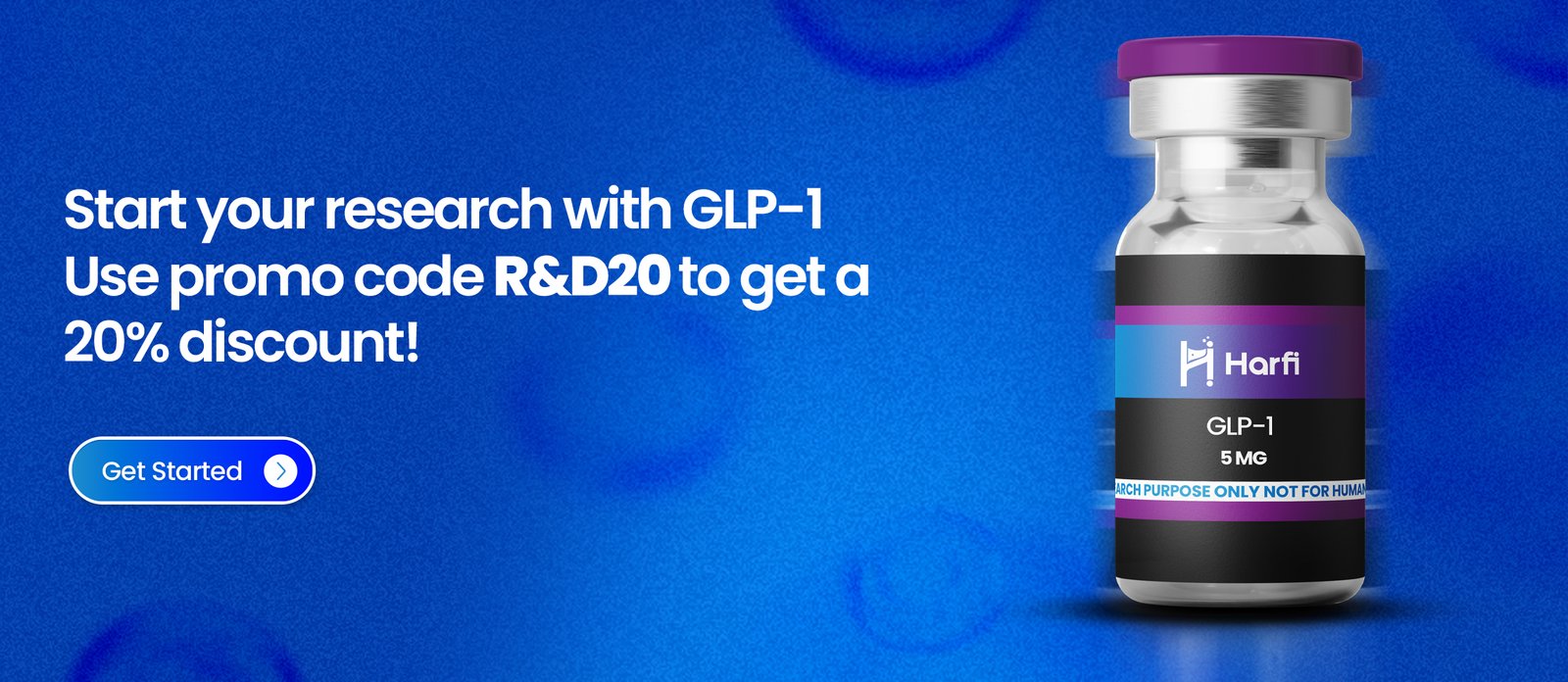GLP-1
GLP-1 is known for its ability to lower blood sugar levels and enhance insulin secretion. Research suggests that GLP-1 may also provide benefits for heart, liver, and lung health, as well as potentially slowing or preventing the progression of Alzheimer’s disease. Studies have shown that GLP-1 significantly reduces appetite by delaying gastric emptying and decreasing intestinal motility. GLP-1 analogs work by stimulating insulin release and suppressing glucagon secretion in a glucose-dependent manner.
Product Usage
This product is intended for research purposes only. It is strictly designated for in vitro testing and laboratory experimentation. All information provided on this website is for educational purposes only. Any introduction into humans or animals is strictly prohibited by law. Only licensed, qualified professionals should handle this product. It is not a drug, food, or cosmetic and must not be misbranded, misused, or mislabeled as such.
GLP-1 Overview
Glucagon-like peptide-1 (GLP-1) is a short, naturally occurring peptide hormone composed of 30–31 amino acids. Its primary function is to regulate blood sugar by enhancing insulin secretion while also protecting beta cell insulin stores by promoting insulin gene transcription. GLP-1 has demonstrated neurotrophic effects in the brain and central nervous system, as well as significant appetite suppression by delaying gastric emptying and reducing intestinal motility.
Research has primarily focused on GLP-1’s role in diabetes management and appetite regulation, with secondary studies exploring its cardiovascular benefits. More recently, research has expanded to investigate its potential in preventing neurodegenerative diseases. Notably, GLP-1 has been found to slow or prevent the buildup of amyloid beta plaques associated with Alzheimer’s disease, making this an emerging and rapidly growing area of study.
GLP-1 Structure

Sequence: HXEGTFTSDVSSYLEGQAAK-OH.steric diacid-EFIAWLVRGRG
Molecular Formula: C187H291N45O59
Molecular Weight: 4113.58 g/mol
PubChem CID: 56843331
CAS Number: 910463-68-2
Synonyms: Oxempic, Rybelsus, NN9535
GLP-1 Research
The Incretin Effect of GLP-1
One of the most significant functions of GLP-1, as highlighted by Dr. Holst, is its role in the incretin effect. Incretins are metabolic hormones released by the gastrointestinal tract that help lower blood glucose levels. Research indicates that GLP-1, along with glucose-dependent insulinotropic polypeptide (GIP), is one of the two primary hormones driving this effect in rodent models. Although GIP circulates at levels nearly ten times higher than GLP-1, studies suggest that GLP-1 is the more potent regulator, especially when blood glucose levels are elevated.
A GLP-1 receptor has been identified on pancreatic beta cells, confirming its direct role in stimulating insulin release from the pancreas. When combined with sulfonylurea drugs, GLP-1 has been shown to enhance insulin secretion to the extent that mild hypoglycemia occurs in up to 40% of subjects. Increased insulin levels promote protein synthesis, reduce protein breakdown, and enhance amino acid uptake by skeletal muscle, contributing to overall metabolic regulation.
GLP-1 and Beta Cell Protection
Animal studies suggest that GLP-1 can stimulate the growth and proliferation of pancreatic beta cells while also promoting the differentiation of new beta cells from progenitor cells in the pancreatic duct epithelium. Additionally, GLP-1 has been found to inhibit beta cell apoptosis, effectively shifting the balance in favor of cell growth. These findings indicate that GLP-1 may hold potential for diabetes treatment and pancreatic protection.
In a particularly notable study, GLP-1 was shown to prevent beta cell death caused by high levels of inflammatory cytokines. In mouse models of type 1 diabetes, GLP-1 demonstrated protective effects on islet cells, suggesting it may play a role in delaying or preventing the onset of type 1 diabetes.
GLP-1 and Appetite Regulation
Mouse model studies indicate that GLP-1 administration in the brain can reduce food intake by decreasing the drive to eat. This effect is believed to be linked to enhanced satiety, helping individuals feel fuller and reducing overall hunger. Clinical studies in mice have shown that twice-daily administration of GLP-1 receptor agonists leads to gradual, linear weight loss over time. This weight loss is associated with improved cardiovascular risk factors and lower hemoglobin A1C levels—a key marker for diabetes severity and blood sugar control.
Potential Cardiovascular Benefits of GLP-1
GLP-1 receptors are widely distributed throughout the heart and have been shown to enhance cardiac function by increasing heart rate and lowering left ventricular end-diastolic pressure (LVEDP). This reduction is significant, as elevated LVEDP is linked to left ventricular hypertrophy, cardiac remodeling, and eventual heart failure.
Emerging evidence suggests that GLP-1 may also help minimize damage caused by heart attacks. The peptide appears to improve glucose uptake in cardiac muscle cells, providing essential nutrients to ischemic heart tissue and preventing programmed cell death. Notably, this glucose uptake occurs independently of insulin, further highlighting the peptide‘s cardioprotective potential.
Studies in dogs have demonstrated that high-dose GLP-1 infusions improve left ventricular performance while reducing systemic vascular resistance. Lower vascular resistance helps to decrease blood pressure and reduce strain on the heart, ultimately mitigating risks associated with long-term hypertension, such as vascular thickening and heart failure. According to Dr. Holst, GLP-1 administration following cardiac injury has consistently improved myocardial performance in both experimental animal models and human patients.
Size of damage in heart in control mice (A), mice given standard vasopressin therapy (B), and mice give GLP-1 (C).
Source: Diabetes Journal
GLP-1 and Brain Health
Emerging research suggests that GLP-1 may play a role in enhancing learning and protecting neurons from neurodegenerative diseases like Alzheimer’s. In one study, GLP-1 was found to improve associative and spatial learning in mice, even reversing learning deficits in genetically altered mice. Additionally, rats that overexpress the GLP-1 receptor in specific brain regions demonstrated significantly better learning and memory compared to their normal counterparts.
Further studies indicate that GLP-1 may protect neurons from excitotoxic damage. In rat models of neurodegeneration, GLP-1 completely prevented glutamate-induced apoptosis, a key contributor to neuronal cell death. Moreover, the peptide has been shown to stimulate neurite outgrowth in cultured cells, suggesting potential neuroregenerative properties. Researchers remain hopeful that continued studies will uncover GLP-1’s potential in slowing or reversing neurodegenerative conditions.
Interestingly, both GLP-1 and its analogue, exendin-4, have been shown to reduce levels of amyloid-beta in mouse models. They also decrease the presence of beta-amyloid precursor protein in neurons. Amyloid-beta is a major component of the plaques associated with Alzheimer’s disease—although its exact role in disease progression remains unclear. While it is uncertain whether preventing amyloid-beta accumulation can slow or stop Alzheimer’s, these findings offer promising insights into potential interventions for cognitive decline.
GLP-1 exhibits minimal to moderate side effects, has low oral bioavailability, and is highly effective when administered subcutaneously in mice. However, per-kilogram dosages in mice do not directly translate to human use. GLP-1 available from Harfi is strictly for educational and scientific research purposes and is not intended for human consumption. Only licensed researchers are eligible to purchase GLP-1.
DISCLAIMER: FOR INFORMATIONAL AND EDUCATIONAL PURPOSES ONLY
All articles and product details provided on this website are strictly for informational and educational purposes.
The product information presented here applies solely to in-vitro studies—experiments conducted outside of living organisms, such as in laboratory settings. These products are not classified as medicines or drugs and have not been approved by the FDA for the prevention, treatment, or cure of any medical conditions, ailments, or diseases.
Furthermore, the use of these products in humans or animals is strictly prohibited by law.

